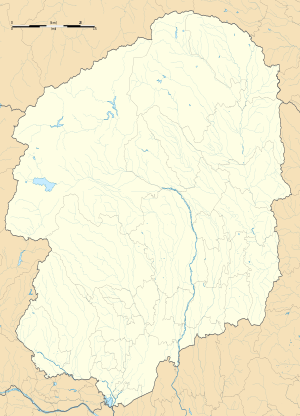Hōshakuji Station
Hōshakuji Station (宝積寺駅, Hōshakuji-eki) is a junction railway station in the town of Takanezawa, Tochigi, Japan, operated by East Japan Railway Company (JR East). The station building was designed by Kengo Kuma and Associates. The station is also a freight terminal for the Japan Freight Railway Company (JR Freight).
Hōshakuji Station 宝積寺駅 | |
|---|---|
 Hōshakuji Station west entrance in 2008 | |
| Location | Hōshakuji, Takanezawa-machi, Shioya-gun, Tochigi-ken 329-1233 Japan |
| Coordinates | 36°37′53.36″N 139°58′46.27″E |
| Operated by |
|
| Line(s) | |
| Distance | 121.2 km from Tokyo |
| Platforms | 1 side platform + 1 island platform |
| Tracks | 3 |
| Other information | |
| Status | Staffed ( Midori no Madoguchi ) |
| Website | www |
| History | |
| Opened | 21 October 1899 |
| Traffic | |
| Passengers (FY2019) | 2,251 |
| Location | |
 Hōshakuji Station Location within Tochigi Prefecture  Hōshakuji Station Hōshakuji Station (Japan) | |
Lines
Hōshakuji Station is served by the Utsunomiya Line (Tohoku Main Line), and is 121.2 km from the starting point of the line at Tokyo. Its is also a terminal station for the Karasuyama Line, a 20.4 km branch line to Karasuyama.
Station layout
The station has an elevated station building, with one side platform and one island platform underneath. The station has a Midori no Madoguchi staffed ticket office.
Platforms
| 1 | ■ Utsunomiya Line | for Yaita, Nasushiobara, and Kuroiso |
| 2 | ■ Utsunomiya Line (Ueno-Tokyo Line) | for Utsunomiya, Ōmiya, Ueno, Tokyo, Yokohama, Atami (via JT Tokaido Line) |
| 3 | ■ Karasuyama Line | for Niita and Karasuyama for Utsunomiya |
Adjacent stations
| « | Service | » | ||
|---|---|---|---|---|
| Utsunomiya Line | ||||
| Okamoto | Local | Ujiie | ||
| Karasuyama Line | ||||
| Okamoto (Through service) |
Local | Shimotsuke-Hanaoka | ||
History
Hōshakuji Station opened on 21 October 1899.[1] With the privatization of Japanese National Railways (JNR) on 1 April 1987, the station came under the control of JR East.
Passenger statistics
In fiscal 2019, the station was used by an average of 2251 passengers daily (boarding passengers only).[2] The passenger figures for previous years are as shown below.
| Fiscal year | Daily average |
|---|---|
| 2000 | 2,046[3] |
| 2005 | 2,036[4] |
| 2010 | 2,213[5] |
| 2015 | 2,203[6] |
Surrounding area
- Takanezawa Town Hall
- Takanezawa Post Office

- Kinugawa River
See also
References
- 日本国有鉄道停車場一覧 [JNR Station Directory]. Japan: Japanese National Railways. 1985. p. 98. ISBN 4-533-00503-9.
- 各駅の乗車人員 (2019年度) [Station passenger figures (Fiscal 2019)] (in Japanese). Japan: East Japan Railway Company. 2020. Retrieved 2 August 2020.
- 各駅の乗車人員 (2000年度) [Station passenger figures (Fiscal 2000)] (in Japanese). Japan: East Japan Railway Company. 2001. Retrieved 5 August 2016.
- 各駅の乗車人員 (2005年度) [Station passenger figures (Fiscal 2005)] (in Japanese). Japan: East Japan Railway Company. 2006. Retrieved 5 August 2016.
- 各駅の乗車人員 (2010年度) [Station passenger figures (Fiscal 2010)] (in Japanese). Japan: East Japan Railway Company. 2011. Retrieved 5 August 2016.
- 各駅の乗車人員 (2015年度) [Station passenger figures (Fiscal 2015)] (in Japanese). Japan: East Japan Railway Company. 2016. Retrieved 5 August 2016.
External links
| Wikimedia Commons has media related to Hōshakuji Station. |
- JR East station information (in Japanese)